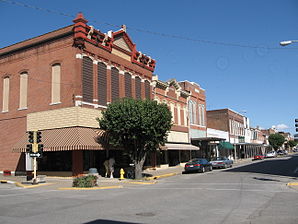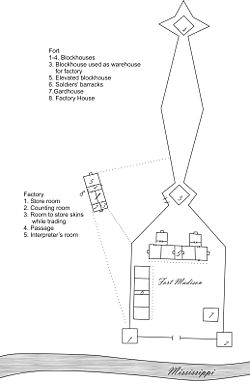Fort Madison
| Fort Madison | |
|---|---|
 Downtown Fort Madison |
|
| Location in Iowa | |
| Basic data | |
| Foundation : | 1808 |
| State : | United States |
| State : | Iowa |
| County : | Lee County |
| Coordinates : | 40 ° 38 ′ N , 91 ° 20 ′ W |
| Time zone : | Central ( UTC − 6 / −5 ) |
| Residents : | 10,520 (as of 2017) |
| Population density : | 440.2 inhabitants per km 2 |
| Area : | 33.5 km 2 (approx. 13 mi 2 ) of which 23.9 km 2 (approx. 9 mi 2 ) is land |
| Height : | 161 m |
| Postcodes : | 52627 |
| Area code : | +1 319 |
| FIPS : | 19-28605 |
| GNIS ID : | 0456689 |
| Website : | www.fortmadison-ia.com |
| Mayor : | Steve Ireland |
 Founding Memorial of Fort Madison |
|
Fort Madison is a small town and next Keokuk one of two administrative seats of Lee County in the extreme southeast of the US -amerikanischen state of Iowa on the west bank of the Mississippi River . The population was 10,520 in 2017.
geography
The city extends over an area of 33.5 km², which is spread over 23.9 km² of land and 9.6 km² of water.
Fort Madison is located on the banks of the Mississippi River, which forms the border with Illinois . The Fort Madison Toll Bridge , which is subject to a fee, crosses the river .
US Highway 61 , which runs from southwest to northeast, runs through Fort Madison . On Highway 61 it is 195 km in a north-northeast direction to Davenport . Iowa capital, Des Moines is 164 miles to the northeast. After Chicago , there are km in a northeasterly direction 401 and to St. Louis in the south there are 320 km.
City features
The Sheaffer company , which today manufactures ballpoint pens and belongs to the BIC Group , was founded in Fort Madison.
The State Prison - a prison with 950 inmates (all three security levels ) and 510 employees - is located in Fort Madison.
Fort Madison also has a station for the Amtrak long- distance express train called Southwest Chief , which crosses the Mississippi River on the route from Chicago to Los Angeles .
The Fort Madison Toll Bridge is the last remaining operational swing bridge on the Mississippi River . It is two-story, the lower level is used by the railway, the road connection runs on the upper level.
In Fort Madison Downtown Commercial Historic District facades preserved can be seen from the 19th century.
History of the fort
Fort Madison was the first US military post on the upper Mississippi River.
The original Fort Madison (1808-1813)
The city arose in the early 19th century around the Fort Madison military post, the first permanently manned military fortification on the upper Mississippi River. Fort Madison was the site where the first battle of Black Hawk against American troops took place in the wake of the British-American War of 1812 . It was the first US military conflict to be fought west of the Mississippi River. Fort Madison is also home to the first US military cemetery in the Upper Midwest .
Fort Madison was one of three posts that would allow the United States Army to take control of the land newly gained by the Louisiana land purchase . Fort Madison was supposed to control the trade on the upper Mississippi River and prevent the surrounding Indian tribes from acts of war. The other two posts were Fort Bellefontaine near St. Louis , which controlled the area around the mouth of the Missouri River , and Fort Osage near what is now Kansas City , which kept the Indian tribes further west in check.
The location of the fort
A controversial treaty with the Sauk and their allies of 1804 allowed the US government to control western Illinois and parts of what is now Iowa. In order to militarily secure this control, the US army decided to build a military fortification at the mouth of the Des Moines River, an important trade route into the interior of Iowa.
Since no suitable land was available directly at the mouth of the Des Moines River, a site was found not far from an Indian village then existing on the heights above the Des Moines Rapids (Des Moines Rapids). This point was the bottleneck for shipping on the upper Mississippi River. Since this location, where the present-day Montrose is located, also did not seem suitable for the construction of a fort, the army decided to build the military post further up on the site of the present-day town of Fort Madison.
The location of the fort, which was first called Fort Belleview , soon turned out to be of little use. It was on a hill not far from a ravine, so that the fort could be taken under fire by enemies from above. The trade led to clashes with the Indians, especially the Sauk. It was intended to build a US trade network, but US trade goods were considered inferior to the French and British , which is why the Sauk declared the 1804 contract invalid.
The chief Black Hawk complained about the construction of the fort in his autobiography:
A lot of people went to see what was happening, I was among them. When we arrived we saw that a fort was being built there. Soldiers were busy sawing wood and I observed that they carried their weapons with them when they went into the forest. Everything about their actions corresponded to the behavior in an enemy country. The chiefs conferred with the officers and foremen, who assured that they were building buildings for a trader who lived here and wanted to sell us many goods cheaply. The soldiers should stay for his protection. We took note of this news and hoped we had been told the truth. But we weren't so good at assuming that the entire building complex was meant to be used for trading. Full of suspicion about the real intentions and very worried, we left the building and went back again.
Black Hawk , autobiography (1882)
Attacks on Fort Madison
Almost from the beginning, the fort was attacked by the Sauk and other tribes. US troops faced furious attacks immediately after leaving and an attempt was made in April 1809 to storm the fort. The attack could only be stopped by using artillery.
Improvements have been made to the fort since its inception. The palisades were raised and a nearby hill was included in the fortifications. However, all improvements to the fort could not compensate for the disadvantage of its location. It was attacked again in March 1812 and besieged in September of the same year. All parts of the fort outside the fortification were destroyed. The attack could only be averted by targeted artillery bombardment of a fortified position by the Indians. Black Hawk took part in the siege and claimed to have personally shot the flag over the fort.
Final siege and surrender
In the course of the British-American War , the Sauk, allied with the British, and other tribes tried to drive the Americans out and regain full control of the upper Mississippi River. In 1813 another siege followed, which finally endangered the fort's existence.
After weeks of siege, the army finally gave up the fort. The crew burned the fort and fled in boats across the Mississippi River. The exact date of the task is unknown, but it probably took place in September 1813.
Soon after, Black Hawk was watching the ruins. We came down the Mississippi in canoes until we got to where Fort Madison had stood. It was abandoned and burned down by the whites and nothing but the remains of the chimneys could be seen. We were delighted that the whites had now left the country.
Ruins and excavations
After the war, settlers built their houses next to the ruins. The resulting city grew and was named after the fort. In the early 20th century a monument was erected on the site of the old fort. Archaeological excavations in the parking lot of the Sheaffer Pen company uncovered the central log cabin of the fort, which once served as officers' quarters. The site was listed on the National Register of Historic Places in 1973 . A replica of the fort can be found elsewhere in town. Much of the work required for this was carried out by volunteer inmates from the nearby state prison.
Use of the site
On the site of the old fort, restoration efforts are under way today. After the Sheaffer Pen factory closed in 2007, the site was sold to those interested in restoration plans. With the argument that Fort Madison is "Iowa's most important historical site", they want to transform the parking lot into a memorial for the soldiers who died in and at the fort. But an agreement for the restoration has not yet been reached.
Demographic data
In the 2000 census, the population was 10,715. These were distributed over 4,617 households in 2,876 families. The population density was 449.2 per km². There were 5,106 buildings, which corresponds to a building density of 214.1 per km².
The population in 2000 was 92.64% white , 2.67% African American , 0.28% Native American , 0.61% Asian, and 2.53% other. 1.28% stated that they descended from at least two of these groups. 5.44% of the population were Hispanics belonging to any of the above groups.
23.6% were under 18 years of age, 8.4% between 18 and 24, 26.1% between 25 and 44, 23.1% between 45 and 64 and 18.8% 65 and over. The average age was 40 years. For every 100 women there were statistically 90.5 men, and 86.3 among those over 18.
The median income per household was $ 34,318 and the median family income was $ 42,067. The average income for men was $ 32,530 and that for women was $ 21,170. The per capita income was $ 18,124. Around 9.8% of families and 12.2% of the total population had their income below the poverty line .
Parish partnership
Fort Madison has had a partnership with the Rhineland-Palatinate city of Prüm (Germany) since 1997 .
sons and daughters of the town
- Dennis O'Keefe (1908–1968), actor
- Marlo Morgan (* 1937), author and doctor
- James Duderstadt (* 1942), physicist, reactor technician and President of the University of Michigan
- Patty Judge (born 1943), politician, Lieutenant Governor of Iowa
Individual evidence
- ↑ US Postal Service - ZIP Codes
- ^ Find a County
- ↑ US Census Bureau: American FactFinder - Community Facts. Accessed December 5, 2018 .
- ↑ Google Maps
- ↑ For general histories of Fort Madison, refer to Jackson 1958, 1960, 1966; Prucha 1964, 1969; Van der Zee 1913, 1914, 1918.
- ↑ Prucha (1964, 1969)
- ↑ Jackson (1958, 1960)
- ↑ Jackson (1960); Van de Zee (1914)
- ^ A b c Project Gutenberg - Black Hawk's autobiography
- ↑ Van de Zee (1918); Jackson (1958; 1966)
- ↑ Jackson (1960); Van der Zee (1913, 1918)
- ↑ a b Van der Zee (1918); Jackson (1958, 1960, 1966)
- ↑ McKusick (1965, 1966)
- ↑ NRHP - Fort Madison
- ↑ Bergin, Nick: “Effort to preserve fort site heats up”. Burlington December 3, 2008
- ↑ Delany, Robin: "Preservationists fear future development will rob Fort Madison of original fort site." Fort Madison Daily Democrat , December 3, 2008
- ↑ Save Fort Madison website
- ^ US Census Bureau - Fort Madison, Iowa

